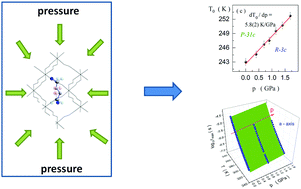Relaxing under pressure with a rigid niccolite formate framework†
Abstract
The rich dielectric properties of hybrid formate frameworks are tightly related to the dipolar dynamics and phase transitions of these compounds. A complete understanding of such phenomena requires experiments performed under non-standard conditions. Herein, we report high-pressure dielectric properties of anisotropic single crystals of a 1,4-diaminobutane zinc-formate framework [NH3(CH2)4NH3][Zn2(HCOO)6]. Experiments performed over wide temperature and pressure ranges allowed us to determine the equation of state of this compound. We reveal that a reversible structural phase transition, associated with a change of the crystal symmetry and partial ordering of the 1,4-diaminobutane cations, is characterized by a linear increase of the transition temperature with increasing pressure (dT0/dp = 5.8(2) K GPa−1). The X-ray diffraction and high-pressure dielectric experiments show that zinc cations together with formate anions form a rigid cage with crystal axis-dependent response to pressure, which affects the dynamics of 1,4-diaminobutane cations. We also demonstrate that the structural phase transition of this compound occurs at a constant value of the dielectric relaxation time (isochronic conditions) further revealing a tight relation between the framework and molecular cations. Our experimental results are supported by the molecular dynamics simulations.



 Please wait while we load your content...
Please wait while we load your content...